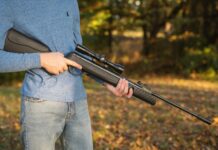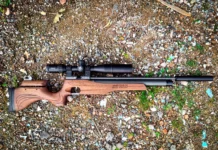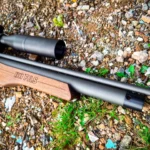Randy Haines of Amery was bowhunting recently when an antlered buck walked near his tree stand in Polk County.
He drew his bow, took aim at the deer and released an arrow, which found its mark.
The events to this point were similar to thousands of other hunting stories in Wisconsin this fall.
But when Haines recovered the animal, he noticed something different.
The young buck had a whitish rump patch and a black tip on its tail. Its facial markings, too, were not something seen on most whitetails.
It was a mule deer, a species found in the western U.S. and parts of Canada and Mexico.
The closest established population of wild mule deer to Wisconsin is found in central South Dakota, according to the U.S. Fish and Wildlife Service.
Haines contacted the Wisconsin Department of Natural Resources and told them about his kill. Conservation wardens and wildlife biologists with the DNR confirmed it was a mule deer.
Haines acted legally in shooting and tagging the animal. He now has one of the most unusual Wisconsin hunting tales of 2015.
The big question is: Where did the muley come from?
Is it a wild deer that traveled from the western U.S. into Wisconsin? Or is it an escapee from a captive facility?
Escapes from deer farms are especially concerning for the health of Wisconsin’s wild deer herd.
If you’re looking at probabilities, a wild mule deer has never been documented traveling 600 or more miles on its own power from its native range into Wisconsin.
On the other hand, animals escape from Wisconsin deer farms or shooting preserves at least several times a year.
State wildlife officials weren’t drawing any conclusions Wednesday.
“At this point, we really don’t know where (the mule deer) came from,” said Bob Nack, DNR big game section chief. “It’s not something we see every day, that’s for sure.”
Nack said the DNR had received reports in recent weeks of a mule deer being sighted and captured on trail cams in northwestern Wisconsin.
So when the kill was reported, it wasn’t a complete surprise.
Conservation wardens inspected the dead buck and found no signs of ear tags or other markings typical of a captive animal, Nack said.
Tissue samples were taken from the mule deer and submitted by the DNR for chronic wasting disease testing.
The deer was not aged by the department, but is thought to be 11/2 to 21/2 years old. It had relatively small, forked antlers and its body appeared to be in good condition.
White-tailed deer, along with their bigger relatives elk (about 200 animals) and moose (a dozen or so), are the only members of the deer family typically found in the wild in Wisconsin.
But a few mule deer have been documented over the years in the Badger State, including one that was killed in 1988, according to Kevin Wallenfang, DNR big game ecologist.
And in 2011, a Vernon County resident sent trail cam photos to Nack that showed what appeared to be a young mule deer.
In was not determined in either case, however, whether the mule deer were wild or escapees.
Could a mule deer walk from its native range to Wisconsin?
If it did, it would have to pass through Minnesota, which has no established mule deer population, according to Pete Takash, fish and wildlife information program leader for the Minnesota Department of Natural Resources.
Depending on where they live, some mule deer do migrate, said Kent Hersey, big game project leader for the Utah Division of Wildlife Resources.
Hersey said typical mule deer movements are 5 to 10 miles between winter and summer ranges, with the extremes being 0 and 100.
Hersey, a native of Pennsylvania, said Wisconsin doesn’t feature typical mule deer habitat.
“I’ve never heard of a mule deer east of the Mississippi River,” Hersey said. “But in some wildlife, a young male will do surprising things.”
Hersey also said this: “You never can discount it being a release from a captive facility.”
Wisconsin has about 500 captive deer facilities. The Department of Agriculture, Trade and Consumer Protection on Wednesday did not provide information on the number of facilities in Wisconsin that have mule deer.
But at least some shooting preserves have captive mule deer and allow paying customers to kill the animals.
Deer Haven Acres in Adams offers mule deer hunting on its fenced shooting preserve, according to its website. And Huntingtripsrus.com advertises mule deer hunts at unspecified locations in Wisconsin.
As chronic wasting disease continues to spread across Wisconsin and other states and provinces in North America, wildlife health advocates are advising increased scrutiny on deer farming practices and regulations.
So a young mule deer several hundred miles out of place isn’t just a novelty that draws interest on hunting chat rooms.
It also raises alarm bells with those concerned about the future of Wisconsin’s wild deer resource.
“I’ve lived in this area my entire life, and I’ve never seen or heard of a wild mule deer here,” said Dave Clausen, a retired veterinarian and former chairman of the Natural Resources Board from Amery. “Maybe we’ll start to see a whole herd of them. Or more likely, it was an animal that escaped. Hopefully we’ll be able to find out.”
Deer farmers are required to report escaped animals. No such reports were available Wednesday.
State wildlife officials didn’t rule out the possibility of it being a wild deer.
“You don’t expect a mule deer in Wisconsin, but when it comes to wildlife, nothing surprises me any more,” Nack said.
Send email to [email protected]








































